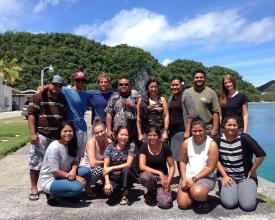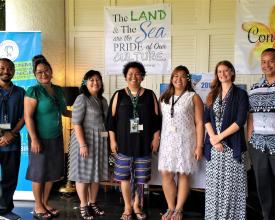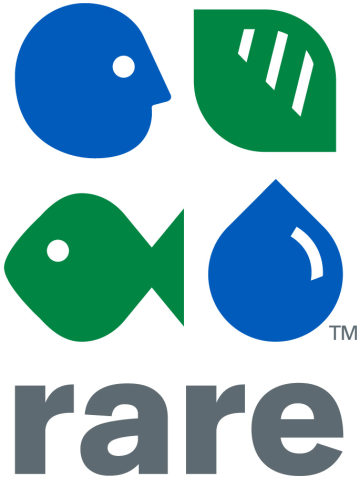Le défi de la Micronésie : Un engagement régional pour la gestion des zones protégées
Le défi de la Micronésie est un engagement pris par les cinq pays et territoires de Micronésie et les partenaires de leurs équipes de soutien régional pour préserver les ressources naturelles qui sont essentielles à la survie des traditions, des cultures et des moyens de subsistance du Pacifique. L'objectif global du défi est de conserver efficacement au moins 30 % des ressources marines proches du rivage et 20 % des ressources terrestres dans toute la Micronésie d'ici à 2020.
Contexte
Défis à relever
Les îles de Micronésie sont des microcosmes exemplaires en matière de conservation et de résilience, avec certains habitats et communautés naturelles que l'on ne trouve nulle part ailleurs sur Terre. Pourtant, ces caractéristiques les rendent particulièrement vulnérables aux menaces environnementales telles que les pratiques de pêche non durables, les espèces envahissantes et la déforestation, toutes aggravées par le changement climatique.
Emplacement
Traiter
Résumé du processus
Blocs de construction
Leadership et engagement politiques de haut niveau
L'annonce du Défi de la Micronésie en 2006 a été le point culminant de décennies de travail de la population et des organisations micronésiennes pour sensibiliser et renforcer la capacité de cette région à conserver et à gérer durablement les ressources naturelles. Au début de l'année 2006, les chefs d'entreprise de chacune des juridictions ont signé le Défi de la Micronésie et l'ont présenté à la communauté internationale lors d'un événement de haut niveau organisé dans le cadre de la 8e Conférence des parties (COP8) à la Convention des Nations unies sur la diversité biologique (CDB), qui s'est tenue en mars 2006 au Brésil. Les décennies de travail préparatoire combinées au bon moment et à la publicité de la COP8 ont créé un moment où les dirigeants politiques se sont défiés les uns les autres pour prendre cet engagement ambitieux. Cet engagement était bien plus ambitieux que les objectifs d'Aichi qui allaient suivre en 2011 (17 % d'espèces terrestres et 10 % d'espèces marines d'ici à 2020). Le fait que les dirigeants politiques au plus haut niveau et dans toute la région se soient engagés à atteindre cet objectif catalyse à la fois la mise en œuvre locale et le financement international de la conservation en Micronésie. Aujourd'hui, le Défi de la Micronésie est devenu une institution bien établie, intégrée dans les priorités gouvernementales et ayant survécu à la rotation des administrations dans chacune des cinq juridictions participantes.
Facteurs favorables
- La volonté politique et le dévouement des dirigeants de chaque île, qui coordonnent leur action par l'intermédiaire du bureau régional du MC (le coordinateur régional du MC et le comité de pilotage du MC, nommés par les chefs d'entreprise des juridictions).
- Le soutien de l'équipe de soutien régional (RST) du Défi de la Micronésie, qui comprend des partenaires nationaux et internationaux, ainsi que des ONG locales de conservation dans chaque île, et le groupe de travail sur les mesures qui développe des indicateurs et suit les progrès.
Leçon apprise
- Le fait de réunir au plus haut niveau des dirigeants dévoués et actifs peut créer une dynamique en faveur d'engagements ambitieux, plus puissants que les engagements individuels des nations.
- Des partenariats solides au niveau local et régional pour accélérer les progrès vers la réalisation de l'engagement.
- Les engagements régionaux tels que le Défi de la Micronésie peuvent être reproduits dans d'autres régions dotées d'un leadership fort. Par l'intermédiaire du Global Island Partnership, le MC a inspiré d'autres défis tels que la Caribbean Challenge Initiative (CCI), le Western Indian Ocean Coastal Challenge (WIOCC), le défi Aloha+, l'initiative des deux Samoa et l'initiative du Triangle de Corail.
Construire des partenariats solides avec l'identité régionale et GLISPA
Le défi de la Micronésie couvre 5 juridictions, des milliers d'îles et plus de 650 000 personnes parlant 12 langues différentes. De nombreux partenaires clés (énumérés ci-dessus) collaborent au Défi de la Micronésie pour soutenir et mettre en œuvre un engagement commun dans toute la région. L'utilisation de l'identité régionale et culturelle partagée des Micronésiens a été un moyen puissant de créer des partenariats durables entre les organisations locales et de base afin de partager les leçons apprises et de ressentir le sentiment d'une cause commune. En outre, l'engagement fiable et ferme des plus hauts dirigeants politiques incite les partenaires internationaux à investir du temps et des ressources dans l'établissement de nouvelles relations, car les investisseurs et les partenaires savent que la conservation bénéficie du soutien total des dirigeants politiques.
Facteurs favorables
L'héritage culturel commun permet de créer une identité régionale micronésienne, qui contribue à unir les différentes parties prenantes et juridictions. Le Global Island Partnership (GLISPA), dirigé par le président de Palau aux côtés du président des Seychelles et du premier ministre de la Grenade, joue un rôle important en présentant le Micronesia Challenge sur la scène internationale. Cela a permis de maintenir l'élan dans la mise en œuvre du MC et d'inspirer d'autres dirigeants à prendre des engagements similaires, tels que l'initiative du Défi des Caraïbes et le Défi Aloha+.
Leçon apprise
- Un travail continu est nécessaire pour maintenir les partenariats du MC et coordonner les actions de conservation dans la région. Le large soutien au niveau local et au plus haut niveau, les objectifs ambitieux et le sens de la cause commune dans la région motivent les partenaires à travailler ensemble, à apprendre les uns des autres et à s'efforcer d'être à la hauteur du Défi de la Micronésie.
- Un réseau solide de partenaires inspire de nouvelles opportunités régionales et tire parti de celles qui existent déjà pour attirer dans la région des partenaires et des financements supplémentaires qui vont au-delà des objectifs du CM. Citons par exemple le premier sanctuaire régional pour les requins à Palau, le plan de biosécurité de la Micronésie pour faire face au risque de propagation des espèces envahissantes, le programme de stages pour les jeunes champions, le soutien allemand Lifeweb pour l'adaptation et la résilience climatiques au niveau communautaire, les accords de partenariat de la NOAA pour la conservation des récifs coralliens et les campagnes de marketing social de RARE Pride.
Financement durable : Fonds PAN et dotations
Tout d'abord, chaque juridiction a élaboré des plans de financement durable, y compris des objectifs et des stratégies de financement, et la création de fonds pour le réseau des zones protégées (PAN). Par exemple, les Palaos ont créé une taxe verte, et les FSM et les RMI travaillent sur la législation relative à la taxe sur les permis de pêche au thon et sur une taxe sur le tourisme afin de soutenir le financement durable du Défi de la Micronésie. Les États de Pohnpei et de Kosrae sont en train de créer des fonds PAN et évaluent un amendement à la loi sur la taxe d'aéroport afin de permettre qu'une partie des frais de départ soit versée au fonds de dotation du Défi de la Micronésie des États fédérés de Micronésie. En outre, plusieurs autres systèmes de financement durable ont été mis en place ou sont en train de l'être (par exemple, le Yela Conservation Easement Endowment, le Awak Sustainable Community Development Revolving Fund, le Nett Water Fund). Une dotation pour le MC est un autre élément important du financement durable. Les revenus d'intérêt d'une dotation d'environ 56 millions de dollars (17 millions de dollars en 2015) seront nécessaires pour compléter les sources locales afin d'assurer la viabilité à long terme du MC dans les cinq juridictions. Bien que les fonds de dotation soient investis ensemble, chaque juridiction possède son propre sous-compte et développera ses propres mécanismes de diffusion des revenus d'intérêts.
Facteurs favorables
- Le Micronesia Conservation Trust (fondé en 2002) disposait d'une structure et de relations en place avant de recevoir des fonds, ce qui a été un élément clé de la réussite du projet. Les succès antérieurs obtenus grâce à des subventions indirectes ont permis d'asseoir la crédibilité du projet.
- Le fonds de dotation a été alimenté par plus de 11 millions de dollars provenant du Fonds pour l'environnement mondial, de The Nature Conservancy (TNC) et de Conservation International, et a permis d'obtenir des ressources supplémentaires de la part des pays.
- Des idées de financement novatrices sont en cours d'élaboration dans chacune des cinq juridictions et au niveau communautaire
Leçon apprise
- Les fonds régionaux de conservation peuvent être un mécanisme puissant pour renforcer les capacités et créer un centre pour les réseaux et les partenariats régionaux, et le MCT a servi de modèle pour d'autres fonds régionaux, tels que le Caribbean Biodiversity Fund (CBF) créé en 2012.
- Le Micronesia Challenge encourage la planification à long terme, car des critères tels que l'établissement de plans de gestion sont requis avant de puiser dans les fonds de dotation.
- Les mécanismes de financement innovants développés dans une juridiction ou par une communauté peuvent être reproduits et étendus à d'autres endroits, car le Micronesia Challenge encourage le partage d'informations pour atteindre un objectif régional.
Impacts
1. Davantage de zones sous conservation efficace : Le MC a contribué à établir ou à renforcer 150 zones de conservation. La Micronésie est sur la bonne voie pour atteindre ses objectifs de 2020, à savoir protéger 30 % des ressources marines et 20 % des ressources terrestres (plus de la moitié de ces objectifs ont déjà été atteints). Le groupe de travail sur les mesures MC a également mis au point l'outil MPAME (Managed and Protected Area Management Effectiveness - Efficacité de la gestion des zones gérées et protégées). Les communautés utilisent cet outil pour améliorer leur gestion en comparant et en suivant l'efficacité des aires protégées dans 12 catégories, sur la base de données provenant de programmes de surveillance à long terme. 2. Financement durable : Une conservation efficace nécessite une série de mécanismes de financement au niveau local et national, tels que les redevances vertes, les redevances touristiques ou les redevances sur les licences de pêche au thon. En outre, une dotation de 56 millions de dollars est en cours de création afin de générer les fonds annuels supplémentaires nécessaires pour soutenir les activités de gestion. En 2019, la dotation a atteint près de 20 millions de dollars. 3. Reproduction dans d'autres régions : Depuis 2006, le Micronesia Challenge s'est avéré être une solution efficace et évolutive. L'initiative du Triangle de Corail (CTI) a suivi son exemple en 2008, le défi côtier de l'océan Indien occidental (WIOCC) en 2012 et l'initiative du défi des Caraïbes (CCI) en 2013.
Bénéficiaires
- Communautés et ménages de Micronésie dont les moyens de subsistance dépendent des ressources côtières, marines et terrestres.
- Initiatives sur les grands océans dans d'autres régions (WIOCC, CCI, CTI, Aloha+)
Objectifs de développement durable
Histoire
Quand une île devient deux - L'histoire de Ben En 2005, Ben Namakin se tenait sur Dekehtikin, son atoll préféré au large de Pohnpei, dans les États fédérés de Micronésie, et n'en croyait pas ses yeux. L'île sur laquelle il avait l'habitude de pique-niquer et de faire de la plongée avec masque et tuba lorsqu'il était lycéen avec ses amis avait été coupée en deux, l'océan s'écoulant désormais sur ce qui était autrefois une terre ferme, emportant le sol et le sable précieux à chaque vague. Pour Ben, le spectre imminent du changement climatique revêt désormais une signification nouvelle et beaucoup plus personnelle. "Oui, c'est peut-être naturel", dit Namakin, "mais peut-être que les gens ont quelque chose à voir avec ça. Je suis très préoccupé par les générations futures." Depuis lors, ce jeune homme de 28 ans à la voix douce est déterminé à partager ses expériences et les histoires d'autres habitants des îles du Pacifique avec tous ceux qui veulent bien l'écouter, et il a réussi à attirer l'attention, tant au niveau local qu'international, sur ses activités et ses préoccupations. Namakin a décidé de réaliser une vidéo sur Dekehtikin et l'a soumise à Greenpeace, qui s'en est emparé. En un rien de temps, il s'est retrouvé à Montréal, au Canada, pour participer à la conférence des Nations unies sur le changement climatique en tant qu'unique jeune délégué des îles du Pacifique. Après avoir participé à plusieurs conférences internationales de haut niveau, M. Namakin déclare que sa plus grande frustration est liée au processus de négociation international et à l'absence générale d'action. Selon lui, si tout le monde parle et agit positivement, il est rare que ces réunions débouchent sur quelque chose de concret. Résigné à la lenteur des négociations internationales sur le climat, il préfère se concentrer sur les domaines dans lesquels il peut apporter une contribution plus immédiate aux communautés vulnérables de Micronésie. La création et la mise en œuvre du Défi pour la Micronésie ont été extrêmement utiles à M. Namakin. "Je m'en sers pour soutenir ma campagne sur le changement climatique", explique-t-il. Je regarde la communauté internationale et je dis : "Vous, les grands pays, vous ne faites rien, mais les dirigeants de ces petits pays coralliens ont signé cet accord et essaient d'économiser nos ressources et de réduire notre vulnérabilité". Le MC montre au monde que nous sommes préoccupés par les problèmes et que nous essayons de les résoudre par nous-mêmes". Il estime que des initiatives telles que le Défi de la Micronésie donnent l'exemple et montrent que les pays vulnérables au changement climatique peuvent exercer leur propre autodétermination lorsqu'il s'agit d'atténuer les effets de l'élévation du niveau des mers et de l'évolution du climat. Pour l'article complet, voir http://mc.aubs.biz/success.php



